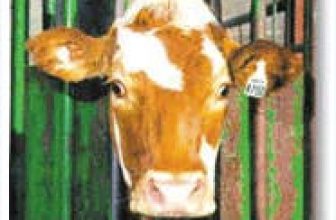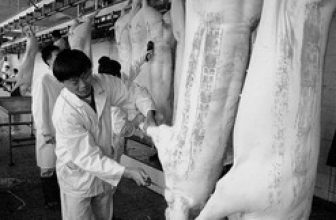
RFID technology traceability enhances the brand influence of rural chicken breeding industry
[ad_1]
The application of RFID technology in the animal husbandry industry mainly has two aspects. On the one hand, it is to establish an animal husbandry management system for fine breeding of animals; on the other hand, it is to establish an animal tracking management system. More than 20 countries and regions around the world have adopted RFID technology to track and trace the food production process, and have achieved good results.
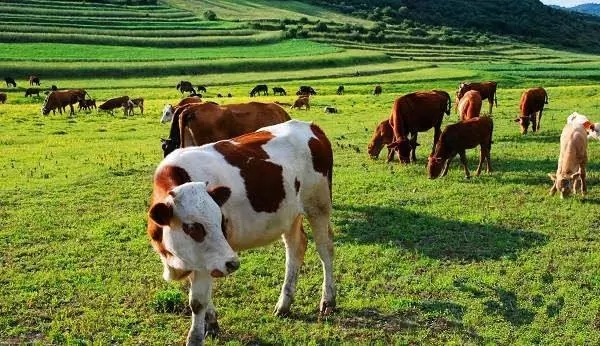
The RFID-based traceability system identifies the management objects in the supply chain links of animal growth, meat processing, storage, and retail, and connects them to each other, and then displays these identifications with bar codes and human readable methods. Once meat products have health and safety problems, these marks can be used to trace back, accurately reduce the scope of safety problems, find out the links where the problems occur, and trace the geographic location of the relevant place of production, slaughter or processing institutions. In this way, the supply of goods in these places can be blocked from flowing into the market, and then effective governance can be carried out.
Step by step chicken project
The chicken farm of the Bubu Chicken Project in Cha’an Town, Anhui Province is quite extensive, and it is not a chicken farm in the traditional sense, but a large area for stocking chickens.
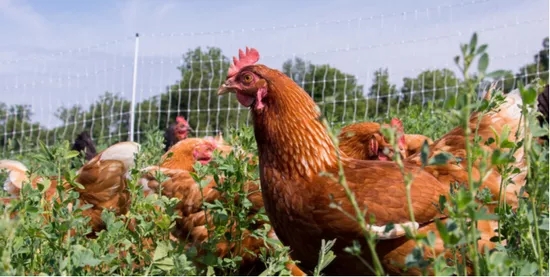
For a long time, the rural aquaculture industry has been at the bottom of the industrial chain. The biggest constraint is the lack of trust between rural and urban areas due to information asymmetry, and rural areas cannot turn their green and pollution-free resources into brand advantages. The blockchain, Internet of Things and other technologies can just solve this problem.
For example, Bubu Chicken mainly solves these pain points of rural chicken farming: no sales channels, low profits, low brand influence, etc. Bubu Chicken has also put forward concepts such as “make the life of chickens transparent and visible” and “blockchain poverty alleviation and free-range native chickens”. On the one hand, it improves the popularity of Bubu chicken, and on the other hand, it also establishes sales channels to solve the problem of rural free-range chickens. The difficulty of no market.
In addition to the use of blockchain and other technologies, the Bubu Chicken Project also introduced the agricultural insurance of property insurance companies to underwrite the risks of chicken breeding. Previously, when farmers insured their farmed chickens with agricultural insurance, risk assessors needed to check on the spot how many farmed assets there were, assess whether these chickens would die, and how much loss of income it would bring…Due to the high evaluation process and cost, Farmers are not very enthusiastic about insuring, and insurance companies have no enthusiasm for underwriting.
The blockchain provides a new idea for agricultural insurance underwriting: because farmers’ chickens use blockchain anti-counterfeiting traceability, how many chickens the farmers raise, and the mortality rate in the past three months… These data only need to be on the blockchain The data can be known in real time, reducing the risk of insurance and credit risk control and evaluation costs, and increasing insurance companies’ enthusiasm for underwriting farmers and breeding assets.
In addition to agricultural insurance, based on the asset data on the blockchain, banks can conduct risk assessments on farmers’ lending, which also promotes the solution of agricultural breeding loan problems, greatly reduces the threshold for entrepreneurial farmers to obtain financial services, and promotes the development of rural entrepreneurship.
Step by step chicken anti-counterfeiting traceability system
Bubuji anti-counterfeiting traceability system mainly includes three systems: data acquisition system, data storage on-chain system, and data verification system.
01Data acquisition system: each chicken has a unique ID
The data acquisition system mainly relies on the ring-shaped buckle IoT device (chicken brand) worn on the chicken leg to collect data (marked in red in the figure below). The chicken brand contains step counting module, positioning module, communication module and so on.
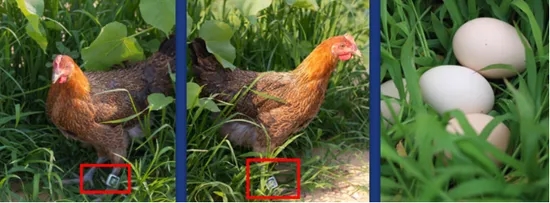
Each chicken card will have a system to generate a unique ID and generate a QR code that can be scanned. The chicken card buckle starts working mode once it is closed and cannot be disassembled. Once disassembled, the electronic link device inside the buckle will be damaged, and the data collection function will be lost.
After the chicken card starts working mode, it will collect the movement steps and coordinates of the uploaded chicken in real time and send it to the communication base station regularly. A communication base station usually includes a main base station and several secondary base stations. The secondary base stations are deployed in a grid pattern and are responsible for collecting data from the chicken cards that are active nearby, and sending the data to the main base station. Then the main base station will send all messages to the message middleware. Since a large number of IoT devices may generate massive amounts of data content, message middleware can serve as a flood storage tank here, cutting peaks and filling valleys.
02Data storage on-chain system: content cannot be tampered with
The system needs to subscribe to the messages in the message middleware, and store and upload the messages to the chain.
Storage: Due to the huge amount of data generated by IoT devices, and the storage limitations of the blockchain itself, all data cannot be directly stored on the chain, so an intermediate storage medium is needed to store the original data.
The intermediate storage medium can be a distributed file system (such as OSS, HDFS), or a decentralized file system (such as IPFS). When testing, you can also use the local file system. The system will periodically collect a certain amount of messages to generate files and store them on the file storage medium.
On the chain: The system will use the SHA-256 algorithm to calculate the data digest of the stored file to obtain the digital signature of the file (because the digital signature of the file is a summary of the original content of the file, any modification to the original content of the file will produce New document signature).
Then the system initiates a blockchain transaction, and puts the storage path of the file, the digital signature of the file, and the previous transaction address (PreHash) into the remarks field of the transaction for uploading to the chain. Once the blockchain transaction is confirmed by the consensus of each node, it will be broadcasted and stored in the ledger of each node, and the content stored in the transaction cannot be tampered with.
03Data query and verification system: scan the code to know the information
After consumers buy chickens, they can query the entire life cycle information of the farmed product, including entry time, number of steps, Coordinates, release time, slaughter time, quarantine organization, logistics information, last transaction address (LastHash) of the blockchain, etc.
Advantages of RFID technology in the application of animal husbandry industry
Electronic identification management has been used in Europe and America for several years and has become a showcase of technology. In addition to the application of automatic feeding and production statistics within the enterprise, it can also be used for animal identification, disease monitoring, quality control and tracking animal species. The main advantages of RFID technology in the livestock industry are as follows:
01Non-contact recognition, real-time and effective data collection
RFID technology uses a non-contact radio frequency identification method to collect and systematically manage the data in the electronic identification placed in or on the animal. It is an extremely effective management method for mastering the health of the animal and controlling the occurrence of animal epidemics.
02Waterproof, can be applied to animal body
The low-frequency tag can penetrate water and animal bodies, and is not sensitive to water and metal. Whether the tag is placed on the animal or on the body, it can be read easily and quickly.
03 unique number, not easy to forge, easy to manage
When the animal is born, the electronic identification is placed on the animal. The electronic identification is one-time use, uniform number, and unique number. Through the traceable management of individual animals and precise feeding, the meat quality is improved; at the same time, health warning and quality monitoring are carried out, which greatly increases the economic benefits of the enterprise.
04Combined with information technology is conducive to tracking management
Through the supporting software management program, the whole process of its growth cycle is monitored. For example, whether it is stocked in a pollution-free natural environment, whether the water, soil, and air indexes meet the standards, the use of veterinary drugs and additives, whether the feed has been contaminated by pesticides or residual additives, etc., and record where it was stocked in different periods. And important information such as its epidemic prevention status and health status. When the food animal reaches the slaughter standard, the slaughterhouse will strictly consult the “quality file” of the animal. Only after strict inspection can it be slaughtered, and the “file” will be archived for future “quality traceability”.
[ad_2]



